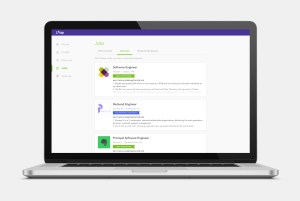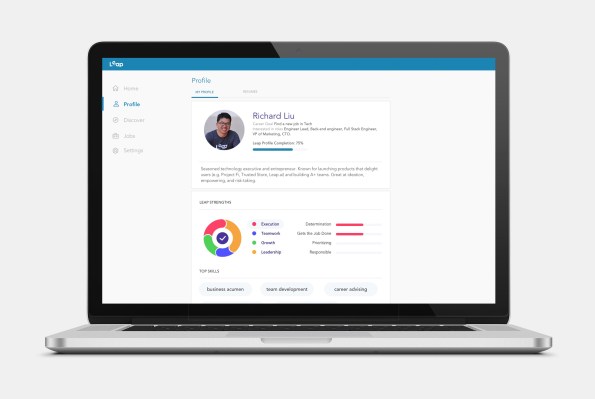Searching for a new job can be a daunting process — especially if you aren’t sure what you’re great at — and even finding the right companies and what jobs are out there is probably enough to make you freeze for a second.
Leap.ai, an intelligent recruiting platform, is looking to make life a little easier for those jobseekers. The company is today launching what it’s calling “Instant Match,” a tool that will match up potential jobseekers that upload their resume with the companies that are based in their database. With a few extra questions, those jobseekers can refine those options down further, and the goal is to find what the employee wants to do — not just what’s on their resume. Initially launched looking to use AI to guarantee interviews for job seekers in tech, co-founder Yunkai Zhou now wants to make it as easy as an instant booking on Airbnb.
“Right now, for a job seeker, there’s two things you do: You go to job boards, and once you go there, you put in a keyword and it returns 2,000 jobs,” Zhou said. “It takes you a very long time to figure out what works. We really believe the right AI tech to apply to this experience is to understand the user really well and give them the job matching results right away. We’ve seen this instant gratification work in other domains, it actually changes user behavior.”
This is a classic problem for both jobseekers and recruiters. A recruiter might get a ping from a company looking to hire a head of product with a laundry list of requirements, or that job just ends up on a job board somewhere on the Internet like Indeed. A user trying to figure out what they like is then going to browse those boards, see an interesting role, and then probably see said laundry list and find that their resumé doesn’t match up. An application might go through, but at the end of the day, jobseekers without a soft intro really only have a cover letter and a resumé to work with.
Now Leap.ai is trying to cut out all of that and do what essentially seems like a robust soft intro, which can infer what skills a person has and what they’re good at — something that probably requires an explanation in person, over the phone, or over some long email thread. But since companies sometimes are combing through hundreds of resumes, jobseekers won’t necessarily get a chance to show what they’re good at without those referrals. Leap.ai looks to use a base of data to try to figure out what someone is good at, figure out what skills a job actually needs, and then match the two.
“A human is actually really a complicated entity,” Zhou said. “But for a human to find this matching job, it’s about a lot more than just the resume or the text in the job description. A human is a lot richer than just a bunch of text on the resume. Every company actually has their hiring criteria that’s not necessarily on the job description. Your description has most likely been copy-pasted. But the really hiring criteria is very dynamic and something that the recruiting team have a much better idea in their heads that doesn’t translate to the job description.”

Leap.ai looks at a user’s profile — either through that resume or through some additional information from questions — and tries to figure out what Zhou says are their “strengths, passions, and preferences,” and then figures out which companies align with that. For example, someone who’s great at Python might not be listing some additional skills on their resume (or may be able to quickly learn them), ones that would easily fit a job description. Leap.ai’s job is to figure out what employees fall under what clusters, which distills into a rich language problem where the company can figure out where an incoming user actually sits on a graph of skills and wants compared to where they think they are.
For now, it’s still a complex problem that requires a lot of information — even if the company can quickly find a match right away. But as the company collects more and more data, it may be able to start automatically ferreting out what a person’s true skill level is and where to get them an interview. Trying to interpret that is a complex problem of both language and a collection of rich, useful data that Leap.ai has worked to collect over time in order to figure out who should go where. And by offering a tool like instant match, it may indeed get more and more information and curious users go to Leap.ai in order to see what’s out there where they may fit.
“We use their resume and from their resume and user experience, either from school projects, we can understand what they’re good at,” Zhou said. “We ask them to do a self-assessment of strengths and top skills. We also ask their peers to get feedback from them. From those peers they can give the answer to top strengths and top scores. The top strengths and skills, combined together, we have a pretty good understanding of this person’s real raw strength.”
There is, of course, a lot of competition in the put stuff in here and let’s find a job space. There are companies like Hired, which require a more robust amount of information but will then review what you send in and try to figure out where to put you. LinkedIn also has collected a treasure trove of data from its hundreds of millions of users that it could begin leaning on for a similar type of product. But the hope is, as experience dealing with the same processes at Google, the company can build a sophisticated enough set of tools — and get users excited enough — that it’ll be able to make those matches (and get those interviews) faster than anything else on the market.
